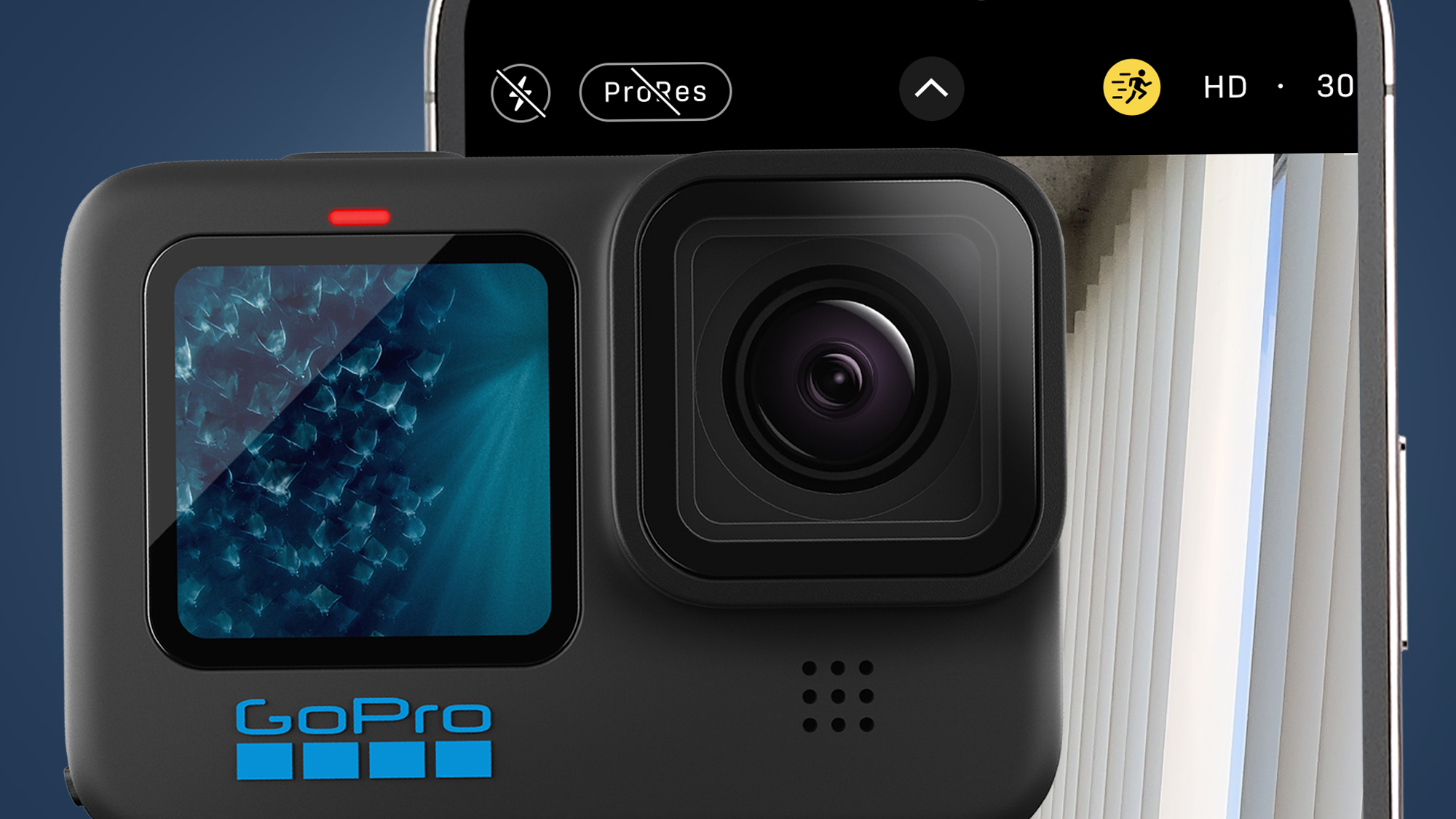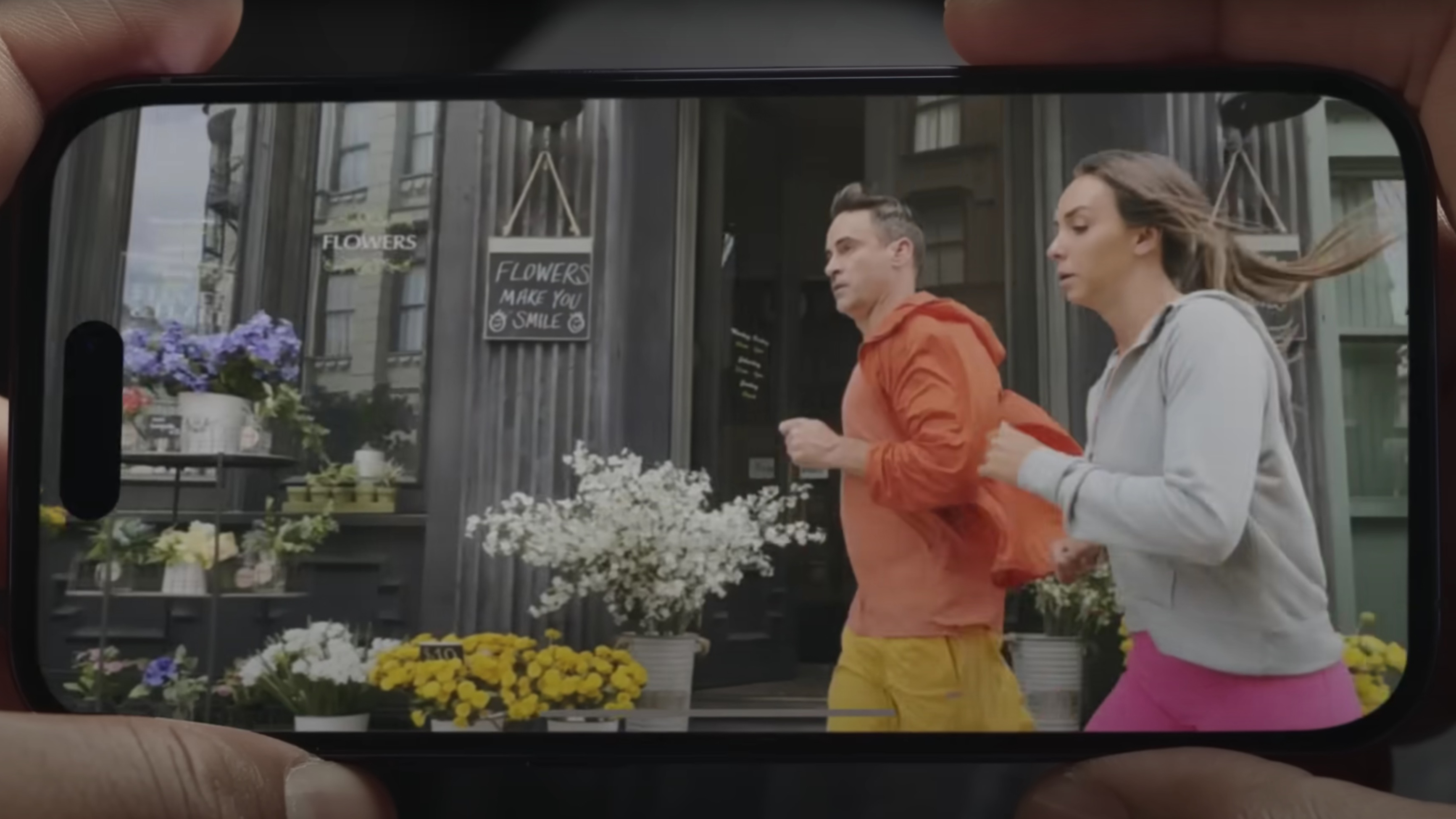The iPhone 14’s new Action Mode can't match the GoPro Hero 11 Black

GoPro is used to fighting the likes of DJI and Insta360 in a Squid Game-style battle for action cam supremacy, but this year, an unexpected contender entered the fray: Apple.
This week we saw the arrival of the highly-anticipated GoPro Hero 11 Black, a direct successor to what is, for us, the best action camera you can buy. But just a week earlier, Apple heckled GoPro by launching its iPhone 14 and iPhone 14 Pro smartphones with a shiny new video feature called Action Mode.
The feature is effectively Apple’s take on GoPro’s HyperSmooth technology, a powerful form of digital video stabilization that works by cropping into the camera’s wide-angle view, leaving the outer edges of the frame free to correct shake and vibrations.

This creates a gimbal-like effect without needing any extra accessories, with HyperSmooth being a staple of GoPro’s action cams since its first introduction on the GoPro Hero 7 Black back in 2018.
Has Apple, then, finally cornered the lucrative action photography market? Tim Cook and company would certainly like to think so, but the reality is a little different. While the iPhone 14’s Action Mode has certainly been impressive in our early testing, it comes with more limitations than the stabilization effects possible on the Hero 11 Black. And the latter, naturally, maintains a degree of durability that Apple’s smartphones just can’t match.
Lost horizons
Why is Apple's Action Mode more limited than GoPro's HyperSmooth? For starters, Action Mode mostly uses the iPhone 14 Pro’s ultra-wide lens (13mm), which has a relatively small 1/2.55in sensor and f/2.2 lens (the standard iPhone 14 has an even smaller sensor and slower f/2.4 lens). Both configurations mean you need plenty of light for Action Mode to function effectively, and it’s likely to struggle (or be unavailable entirely) in gloomy environments.
The Hero 11 Black, on the other hand, boasts a larger 1/1.9in sensor that means its HyperSmooth feature can work in moderately lower light. It’s still not brilliant in these situations, mind, but you’ll certainly get more versatility from the GoPro than the iPhone when you’re out and about in the mountains, on the water or wherever else you like to get your adrenaline kicks.
Sign up for breaking news, reviews, opinion, top tech deals, and more.
This 1/1.9in sensor, and in particular its 8:7 aspect ratio, also gives the Hero 11 Black wiggle room for more stabilization tricks, like the very impressive 360-degree Horizon Lock.
The GoPro Hero 10 Black already uses 'Horizon Leveling' technology to correct footage that's been skewed by up to 45 degrees, but the Hero 11 Black takes the feature one step further by keeping footage straight even when the camera rotates a full 360 degrees.
This works with all resolutions and frame rates (except for 5.3K/60p, 4K/120p, 2.7K/240p or 1080/240p, where you’ll get standard Horizon Leveling for angles up to 27 degrees), and in our brief experience testing the Hero 11 Black, we were mightily impressed by just how effective Horizon Lock proved to be.
Apple’s Action Mode doesn’t offer you the same degree of freedom to haphazardly move your iPhone camera up, down, left and right without losing stable orientation. Granted, most users won’t be tossing their devices into a horizon-altering spin – and Action Mode does have some roll correction – but the Hero 11 Black’s inclusion of Horizon Lock marks another small victory over the iPhone-as-action-cam.
Smooth operator
The same goes for the amount of control you’re able to exercise over the GoPro’s level of stabilization. The Hero 11 Black offers various degrees of HyperSmooth – standard, Boost and AutoBoost – which lets you tailor stabilization to specific activities.
For example, you don’t always want a super-smooth, floating effect for things like mountain biking, where a little judder can create a more realistic look. The Hero 11 Black – unlike Apple’s Action Mode – allows for a more relaxed crop, and these different HyperSmooth strengths are available in pretty much any resolution, frame-rate or digital lens.
Right now, GoPro's stabilization also beats its Apple rival for resolution options. The Hero 11 Black gives you stabilization for footage shot in up to 5.3K/60p, compared to just 2.8K on the iPhone. Then there’s the extra effects at your disposal with GoPro, like TimeWarp, which combines timelapses with HyperSmooth to let you capture super-stabilized timelapse videos while you move through a scene.
Naturally, the GoPro’s durability is also a factor, too. Apple beefs up the structural integrity of its iPhones on an annual basis, but there’s no way a four-figure-costing iPhone 14 Pro gets taken into the mountains or onto the water without some form of additional protection.
The Hero 11 Black, though, is ready to rock straight out of the box. Its casing is pretty much indestructible – we put its scratch-resistant lens cover to the test during a particularly gnarly mountain bike incident, and the camera remained completely unblemished – and its built-in mount makes attaching it to action-y things like handlebars and surfboards a breeze.
Action replay
To be clear, we're certainly not discrediting Apple’s Action Mode. We were glad to see the feature announced at the company’s September launch event, and it’s so far proven an effective (if not quite gimbal-level) method of casual stabilization in our early testing.
We also expect to see Action Mode become much more powerful in the years to come – Cinematic Mode, for instance, was recently upgraded to 4K resolution, having been limited to 1080p at launch.
But Apple’s first major foray into action videography remains, for now, a feature that's mainly designed to enhance footage captured while walking and running. Action Mode is not, as some have suggested, the GoPro killer – at least not for those who engage in more adventurous (read: most outdoor) sporting activities.
The Hero 11 Black offers better quality video, more granular control over stabilization and a host of useful effects like Horizon Lock and TimeWarp, as well as the obvious durability benefits granted by its sturdy design.
Apple’s shiny new mode may well eat into the Hero 11 Black’s appeal for vloggers, though, which could impact the popularity of GoPro's Hero 11 Black Creator Edition and other vlogging cameras like the Sony ZV-1. Between an improved Cinematic Mode and Action Mode, the iPhone 14 series could definitely carve itself a place among the best vlogging cameras.
We’ll be running a more comprehensive side-by-side comparison between the GoPro Hero 11 Black and iPhone 14's Action Mode soon, so stay tuned to TechRadar for our final verdict. If you've been trying to figure out how GoPro's new flagship actually differs from predecessor, you can check out out GoPro Hero 11 Black vs Hero 10 Black comparison, too.

Axel is TechRadar's Phones Editor, reporting on everything from the latest Apple developments to newest AI breakthroughs as part of the site's Mobile Computing vertical. Having previously written for publications including Esquire and FourFourTwo, Axel is well-versed in the applications of technology beyond the desktop, and his coverage extends from general reporting and analysis to in-depth interviews and opinion.
Axel studied for a degree in English Literature at the University of Warwick before joining TechRadar in 2020, where he earned an NCTJ qualification as part of the company’s inaugural digital training scheme.
- Mark WilsonSenior news editor


